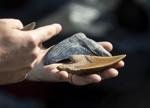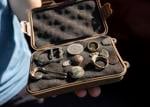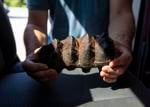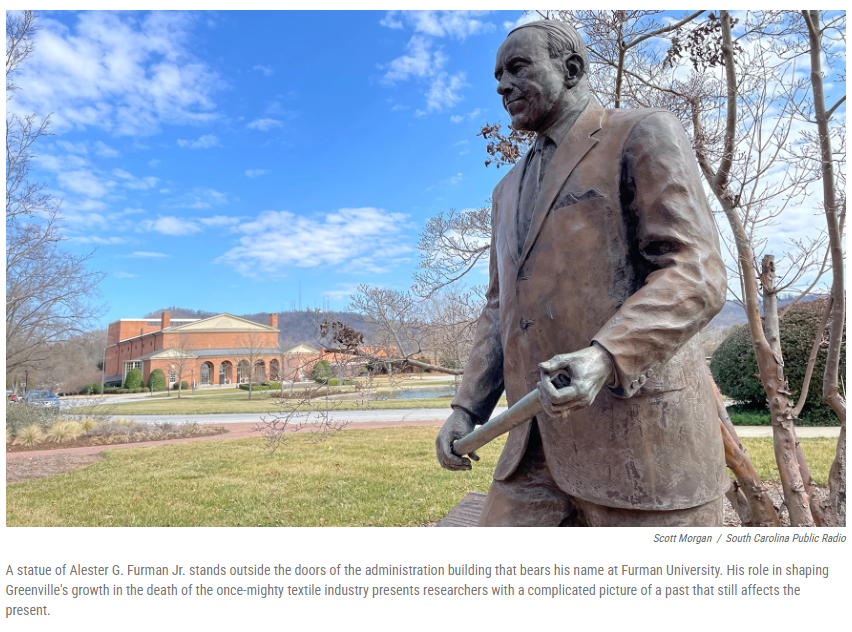SOUTH CAROLINA: Lowcountry Fossil Hunter is Sharing Ancient Finds in a Modern Way
GOOSE CREEK — Waist-deep in a Charleston-area river, a pair of goggles atop his head and inflatable tubes floating around him, fossil and treasure hunter Matthew Mitchell held up a mastodon tooth — a tens of thousands of years old fossil that belonged to an elephant-like animal.
Even after all those years tumbling around in the river, the molar is hefty and solid. It quickly became a viral sensation on his TikTok page, @huntingforadventure with one million views.
Mitchell shares his discoveries on social media for viewers young and old, both familiar with the art of the fossil hunt and those new to the craft.
For him, it’s a way to ignite the passion for the hobby and get viewers interested in local history. He’s part of a population of fossil hunters in Charleston who are eager to look below the surface of the Lowcountry for relics of the past, some dating back millions of years.
Charleston’s rivers, creeks and beaches, rich with physical remnants of days gone by, are the perfect settings for his quests.
Going on a treasure hunt
Mitchell stood by his red pickup on Aug. 16, ready to comb through a small creek that can’t even be found on a map. In the bed of his truck are his tools, a metal sifter, gloves and plastic bags he’ll use to store his finds.
He hoists the equipment out of the truck and begins the descent into the creek. Large slabs of limestone make up a crude path for a short distance before Mitchell must brave the ankle-deep water, being mindful of where he places his feet. Landscaping stones loosely line the creek bed and make for a slippery journey at some junctures.

Mitchell displays megalodon teeth he found while fossil hunting in creeks around the Summerville area.
Once Mitchell is satisfied with how far he’s walked, he pulls on a pair of white and blue gloves. He crouches down, scooping handfuls of rock, clay and gravel onto the metal sifter lined with pool noodles.
Once he’s collected enough material, he submerges the tool in the water, shaking it back and forth gently until the clay has washed away. All that’s left are rocks and pebbles, at least to the untrained eye.
Mitchell scans his spoils and immediately he spots it: a megalodon tooth.
(Clicking on any video link constitutes consent to collection and sharing of your personal video viewing data with various Post and Courier partners.)
Within about an hour and a half of this simple routine — dig, sift, search, dig, sift, search — his efforts have turned up three megalodon teeth, mouth plates from stingrays and puffer fish, a fish vertebrae and other shark teeth.
The bed of the creek is roughly 30 miles from the ocean, yet shark teeth are everywhere, revealed in nearly every batch of sediment Mitchell sifted through.
The finds are so prominent because millions of years ago Goose Creek and much of the Summerville area were underwater, and large animals, now long gone, like the megalodon, swam the waters.

Mitchell opens up a small box of some of his most prized finds, including a gold ring he uses as his wedding band.
“In Goose Creek and Summerville, streams and creeks are cutting into geological strata that are Eocene (55 million years old) to Pliocene (2.6 million years old) in age,” said Katie Luciano, a coastal geologist with the S.C. Department of Natural Resources. “As sea level has risen and fallen in more recent times over South Carolina’s Coastal Plain, these deposits have been re-worked, concentrating fossils like shark’s teeth.”
Today, their teeth are all that are left behind, waiting to be found by fossil hunters like Mitchell and shared with the world.
Bringing old finds to new audience
Mitchell has amassed roughly 60,000 followers on TikTok interested in what he finds and where, though treasure hunters tend to keep the latter more secret.
“I got serious about my channel in 2021 in the midst of the pandemic. Falling in love with treasure hunting made me want to share and teach others about the hobby,” he said. “My following quickly grew and I was able to reach millions with my videos which felt pretty unreal.”
His channel is a space to share the hobby and get more people interested in fossil hunting. It’s also a place where he can document his finds, like the rare mastodon tooth or the jewelry he’s uncovered metal detecting on beaches.
Posting his hunts online has connected him to a network of fellow treasure hunters and adventurers, like Andrew Knox.
Knox also shares his finds on his TikTok, @andrewsadventures. Born and raised in Texas, Knox began fossil hunting and metal detecting when he was a child, learning the ins and outs of the hobby from his grandparents’ next-door neighbor.
For Knox, finding fossils and pieces of history lost to time is an exciting way to preserve local history. Each discovery presents a puzzle and he uses context clues to determine its origin.
Like Mitchell, he’s unearthed shark’s teeth and rings, cannonballs and coins. Some of his more interesting finds include two sterling silver gravy boats from the site of a Revolutionary War-era British encampment in Charleston.

Matthew Mitchell displays a Mastodon molar fossil he found on a previous fossil hunting trip, Friday, Aug. 16, 2024, in Goose Creek.
“These two silver gravy boats are marked on the bottom with various hallmarks that you would expect to see with a piece like that, denoting where it’s from, who made it, what time period it was made. The time period it dates to exactly the time that the British were there,” Knox said.
His page started as a way to memorialize his finds. Today, roughly 30,000 users follow the account to watch him comb the beaches with his metal detector.
As he’s posted his adventures online, Knox said he’s noticed a revived interest in the hobby that was typically perceived as one for older individuals.
“I think social media has changed people’s perception of the hobby over the years,” Knox said. “Now that this hobby has myself and so many more others putting it on social media, it’s been really refreshing to see a hobby that when I was young, it was really a dying hobby.”
Sharing and growing the craft with others
There are certain rules to follow when fossil hunting, like the Underwater Antiquities Act, which states that hunters can’t use machinery or mechanical tools to dig into the earth to search for fossils.
“If you’re fossil hunting, make sure that you’re not digging into the banks,” Knox said. “Leave the property, whether it’s public or private, better than you found it.”
Mitchell often invites his followers to join him on hunts. What they find, they keep. He’s already found everything he needs, he says, and is happy that he’s able to get people engaged in the hobby.
Some local businesses, like Charleston Fossil Adventures and Palmetto Fossil Excursions, offer excursions for those interested in fossil hunting, but are less eager to dive headfirst into a murky creek.
Getting into the hobby is relatively cheap, Knox said. About $300 gets you a basic metal detector and a shovel, and “away you go.”
Ask any treasure hunter, and they’ll tell say the process is mundane, time-consuming and often, frustrating. Yet the second a gold ring is found, or if you’re lucky, a giant tooth from a long-gone animal, you’re hooked.

Matthew Mitchell walks up a sewer pipe with his sifting equipment on a morning fossil hunting trip Aug. 16 in Goose Creek.
–postandcourier.com



